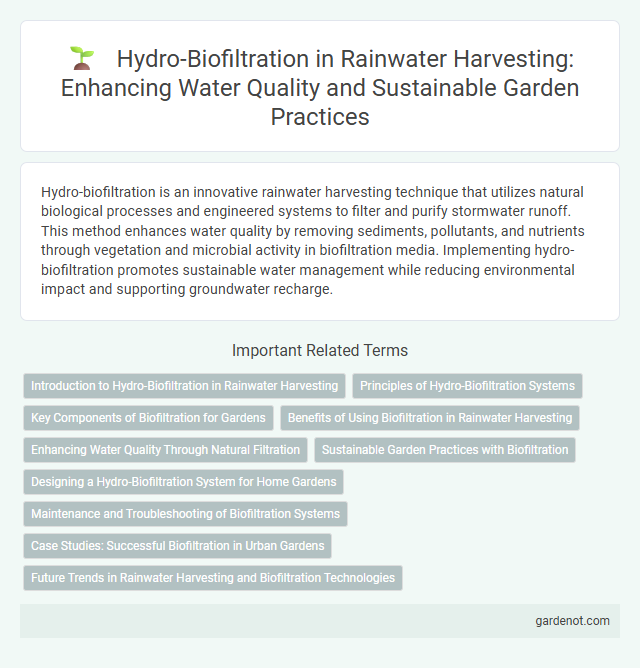Hydro-biofiltration is an innovative rainwater harvesting technique that utilizes natural biological processes and engineered systems to filter and purify stormwater runoff. This method enhances water quality by removing sediments, pollutants, and nutrients through vegetation and microbial activity in biofiltration media. Implementing hydro-biofiltration promotes sustainable water management while reducing environmental impact and supporting groundwater recharge.
Introduction to Hydro-Biofiltration in Rainwater Harvesting
Hydro-biofiltration is an advanced rainwater harvesting technique that integrates biological and mechanical filtration processes to enhance water quality. By utilizing natural vegetation and engineered substrates, it effectively removes sediments, nutrients, and pollutants from runoff before it enters storage systems. This method improves groundwater recharge and supports sustainable water management in urban and agricultural environments.
Principles of Hydro-Biofiltration Systems
Hydro-biofiltration systems operate on the principle of combining physical filtration with biological processes to treat rainwater. These systems use natural media such as soil, plants, and microbial communities to remove pollutants, sediments, and nutrients through mechanisms like sedimentation, adsorption, and biodegradation. By mimicking natural water cycles, hydro-biofiltration enhances water quality while enabling sustainable rainwater harvesting and management.
Key Components of Biofiltration for Gardens
Key components of hydro-biofiltration for gardens include a multilayered substrate system composed of coarse gravel, sand, and organic-rich soil to facilitate efficient water percolation and nutrient retention. Vegetation such as native grasses and water-tolerant plants plays a critical role in filtering pollutants and enhancing microbial activity within the biofilter media. Incorporating an engineered drainage layer ensures optimal water flow control, preventing surface runoff and promoting soil moisture regulation essential for sustainable rainwater harvesting.
Benefits of Using Biofiltration in Rainwater Harvesting
Biofiltration in rainwater harvesting effectively removes pollutants such as sediments, nutrients, and heavy metals, enhancing water quality for reuse and groundwater recharge. This natural filtration process supports sustainable water management by reducing urban runoff and minimizing environmental contamination. Implementing hydro-biofiltration systems also promotes biodiversity and improves the ecological health of surrounding landscapes.
Enhancing Water Quality Through Natural Filtration
Hydro-biofiltration leverages natural processes using vegetation and soil microorganisms to enhance rainwater quality by removing pollutants and sediments. This method significantly reduces contaminants such as heavy metals, nutrients, and organic matter, promoting cleaner runoff for reuse or groundwater recharge. The integration of native plants and bioactive substrates creates an efficient filtration system that supports sustainable water management and ecosystem health.
Sustainable Garden Practices with Biofiltration
Hydro-biofiltration integrates natural vegetation and engineered filtration systems to enhance rainwater harvesting by promoting pollutant removal and groundwater recharge. Sustainable garden practices using biofiltration include constructing rain gardens, vegetated swales, and permeable landscapes that capture and treat stormwater while supporting biodiversity. These methods reduce runoff, improve water quality, and contribute to resilient urban ecosystems by mimicking natural hydrological processes.
Designing a Hydro-Biofiltration System for Home Gardens
Designing a hydro-biofiltration system for home gardens involves integrating layers of natural materials such as gravel, sand, and activated carbon to filter rainwater efficiently. Incorporating native plants with deep root systems enhances the system's ability to absorb pollutants and improve water quality. Optimizing flow rate and maintenance routines ensures sustained performance and supports sustainable water management in residential landscapes.
Maintenance and Troubleshooting of Biofiltration Systems
Effective maintenance of hydro-biofiltration systems involves regular inspection of filter media to prevent clogging and ensure optimal water flow. Routine removal of accumulated debris and replacement of saturated substrates enhance microbial activity and filtration efficiency. Troubleshooting common issues such as reduced infiltration rates or foul odors requires assessing biofilm health, adjusting hydraulic loading rates, and verifying system integrity to restore performance.
Case Studies: Successful Biofiltration in Urban Gardens
Hydro-biofiltration systems in urban gardens effectively reduce stormwater runoff and improve water quality by filtering pollutants through vegetation and soil media. Case studies from cities like Portland and Melbourne demonstrate significant decreases in nutrient loads and sediment during rain events, enhancing groundwater recharge and supporting urban biodiversity. These biofiltration installations offer sustainable rainwater harvesting solutions that mitigate flooding risks and promote resilient green infrastructure.
Future Trends in Rainwater Harvesting and Biofiltration Technologies
Emerging trends in rainwater harvesting emphasize integrating hydro-biofiltration systems to enhance water quality and storage efficiency, leveraging bioengineered filtration media and microbial processes to remove contaminants naturally. Advances in sensor technology and IoT enable real-time monitoring and adaptive management of filtration performance, optimizing system responsiveness to varying rainfall patterns and pollutant loads. Future developments predict scalable, modular designs that combine green infrastructure with smart filtration, promoting sustainable urban water cycles and mitigating stormwater runoff impacts.
Hydro-biofiltration Infographic

 gardenot.com
gardenot.com